The wide and diverse range of marine oil products, and the omega-3 content they all offer, has ascended the ranks to health staple status over recent years. Consumers are now beginning to plumb deeper into the inner lives of their marine oil selections, and to ask more of them in both efficacy and stability. “As the consumer becomes more sophisticated, reasonable expectations are that they will demand higher potency, more bioavailable and bioactive forms of the ingredient, and source and dosage form diversification,” states Kenn Israel, vice president of marketing for Robinson Pharma, Santa Ana, CA.
Many marketers of marine oils are promoting, and accentuating in their formulas, some of the other healthy components that are commonly found in marine oils, beyond omega-3s. How important these are and how much we really know about them is a subject worthy of debate and discussion. 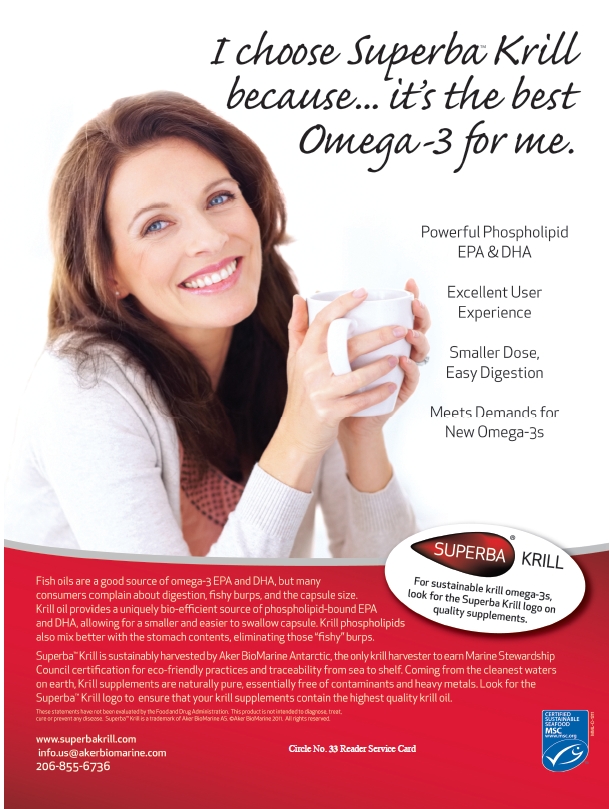 Aside from the well-worn brain and heart healthy properties of omega-3s, some little-known, niche benefits also merit a look.
Aside from the well-worn brain and heart healthy properties of omega-3s, some little-known, niche benefits also merit a look.
The marine oils market presents many other issues of which to be aware. We’ll examine the significance of the increasingly popular Omega-3 Index, the issues surrounding purifying and concentrating marine oils, the sustainability of the krill fishery, and finally, insiders will tell us what they see coming on the horizon for the category as a whole.
What’s in an Oil?
There is emerging evidence that some less-heralded compounds in marine oils besides EPA and DHA may have a role to play in our health. This is a market segment with many veteran consumers looking for cutting-edge products, experts say, and one that will have to become more advanced in order to continue to grow. In that context, the “other” components in marine oil formulas may present a new frontier of sorts.
Bo Martinsen, M.D., co-founder of Omega3 Innovations, Venice, FL, argues that to truly take advantage of all that marine oils offer our health, freshness and stability must be priorities for manufacturers. “Another aspect I think is extremely important for people to understand is that omega-3 is a family with a large number of different components,” he says, explaining that beyond the two that get the most air time, there are compounds such as DPA, EDA, ALA and a number of unnamed omega-3s to consider. He points to the importance in epigenomics, the study of heritable changes in DNA that can be exerted by the environment, of the synergy and interaction of this multitude of dietary substances taken together, rather than in isolation.
 The fatty acid club, as a whole, has a much bigger roll call than many realize. According to Trisha Sugarek MacDonald, BS, MS, director of research and development/national educator for Bluebonnet Nutrition Corp., Sugar Land, TX, about 60 different fatty acids have been identified in human blood and tissue. “With all the omega numbers out there—3s, 5s, 6s, 7s, and 9s, to a name a few—it’s no wonder that people get confused,” says Tone Larsen, product development manager at Nordic Naturals, Watsonville, CA. Fish oil from Larsen’s company will typically contain 36 varieties of fatty acids.
The fatty acid club, as a whole, has a much bigger roll call than many realize. According to Trisha Sugarek MacDonald, BS, MS, director of research and development/national educator for Bluebonnet Nutrition Corp., Sugar Land, TX, about 60 different fatty acids have been identified in human blood and tissue. “With all the omega numbers out there—3s, 5s, 6s, 7s, and 9s, to a name a few—it’s no wonder that people get confused,” says Tone Larsen, product development manager at Nordic Naturals, Watsonville, CA. Fish oil from Larsen’s company will typically contain 36 varieties of fatty acids.
Only a select number of these are deemed biologically important, and this is also something consumers may not have a handle on. “Why wouldn’t someone also want omega-5 and -7s as well in their diet, right? If it is an omega—it must be good for you,” Sugarek MacDonald says. She explains that including or featuring less-researched compounds in marine oil products may make a company look innovative, and consumers may view such products as a way to “get all their omegas.” She emphasizes that these lesser-known compounds likely have their biological place, so to speak, but that there is not enough evidence to date to support specific structure or function applications for most of them.
“In the past when companies were standardizing their materials, they only looked to what consumer preferences were in the marketplace as well as what scientifically sound research was condoning,” such as DHA for brain health, Sugarek MacDonald says. But, technological advancements in the assay testing of fish and plant oils has allowed raw material companies to identify fatty acid profiles in their oils (plant or animal based) and supplement products can now be labeled for those components.
Also starring. One of the lesser-known 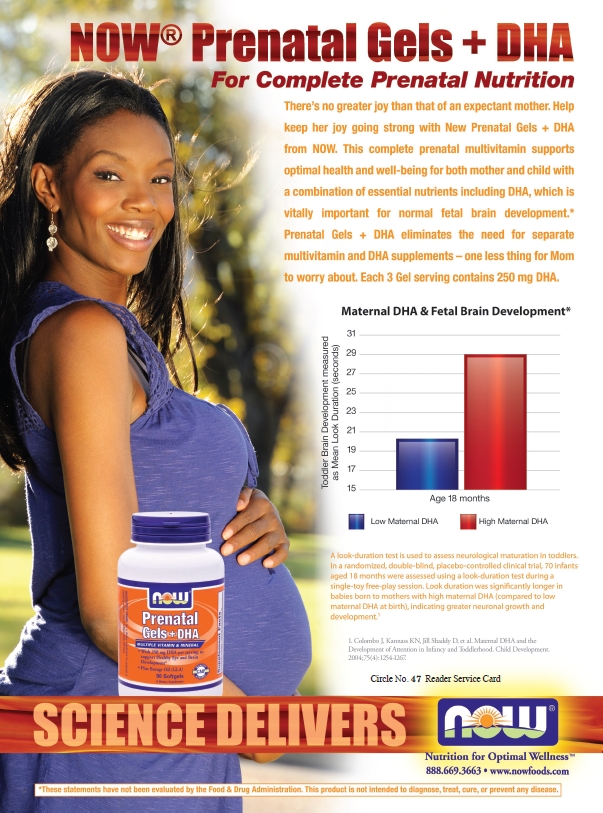 fractions that’s been mentioned, DPA, is actually a biological intermediary between EPA and DHA. “It is not clear that there are advantages to supplementing DPA when one can supplement pre-formed EPA and DHA,” says Dallas Clouatre, Ph.D., consultant for R&D at Jarrow Formulas, Los Angeles, CA. He adds that instead, a more effective approach toward gaining health benefits might be to focus on improving the bioavailability of EPA and DHA.
fractions that’s been mentioned, DPA, is actually a biological intermediary between EPA and DHA. “It is not clear that there are advantages to supplementing DPA when one can supplement pre-formed EPA and DHA,” says Dallas Clouatre, Ph.D., consultant for R&D at Jarrow Formulas, Los Angeles, CA. He adds that instead, a more effective approach toward gaining health benefits might be to focus on improving the bioavailability of EPA and DHA.
DPA is nevertheless nutritionally important, and there are some things we know about it. For instance, “DPA intake begins early as a beneficial component of human breast milk, helping to support cellular membrane formation and function,” says Michele McRae, C.N., senior director of new product development for Rainbow Light Nutritional Systems, Santa Cruz, CA.
Beyond this, the health implications of DPA are still unclear. “There is great need for more research on DPA because so little has been done, due to a lack of pure DPA material. Nevertheless, the studies conducted so far indicate some significant health benefits,” says Herb Joiner-Bey, N.D., scientific advisor to Barlean’s, Ferndale, WA.
As an intermediate in the conversion pathway between EPA and DHA, DPA can be converted back to EPA for the production of hormones, according to Joiner-Bey. He goes to say that the liver can convert DPA to DHA as it is needed. On its own, DPA has been found to inhibit platelet clumping better than EPA and DHA in lab experiments. This reduces the tendency toward blood clotting that represents a risk factor for heart attack and stroke. Similarly, it has been found to have 10 times the potency of EPA and DHA in stimulating cell activity related to wound healing. DPA also appears to protect normal brain function in lab animals as they age. Finally, it may help to reduce serum triglyceride levels, as do EPA and DHA, by modulating the expression of genes that control fat production in the liver.
 A case can be made, Israel says, for DPA’s role alongside EPA and DHA, because the original published studies that began the omega-3 craze 30 years ago examined Eskimo populations that consumed seal blubber rich in EPA, DHA and DPA. The problems to be solved, in his view, are which amounts of DHA and other compounds are effective for health, and what levels we can realistically expect to find in marine oils. “DPA may emerge as significant as have other fractions found in foods and unrefined oils, but the questions and credibility start with the dose,” Israel says.
A case can be made, Israel says, for DPA’s role alongside EPA and DHA, because the original published studies that began the omega-3 craze 30 years ago examined Eskimo populations that consumed seal blubber rich in EPA, DHA and DPA. The problems to be solved, in his view, are which amounts of DHA and other compounds are effective for health, and what levels we can realistically expect to find in marine oils. “DPA may emerge as significant as have other fractions found in foods and unrefined oils, but the questions and credibility start with the dose,” Israel says.
Another common set of compounds found in unrefined marine oils are omega-7 fatty acids. The knowledge here, too, is relatively scant, but some promising threads are emerging. Clouatre cites a study in which an omega-7 called palmitoleate was found to benefit lipid metabolism in the liver in a fashion similar to EPA (1). McRae adds that omega-7s are associated with skin suppleness, and that a separate class of fatty acids, oleic acid or omega-9, is found to support beneficial cholesterol ratios and a decreased risk of heart disease. Oleic acid was found in one study to inhibit cholesterol production in certain cells (2).
While some manufacturers may feature DPA or naturally occurring proteins in their marine oils, the research is only conclusive for the well-established omega-3s, summarizes Brandon Nomura, territory manager for Soft Gel Technologies, Los Angeles, CA. He states, “Although some of the non-EPA/DHA components naturally occurring in fish oils may have significance for the nutraceutical market and consumer health in the future, at this time, there isn’t enough clinical evidence of efficacy to warrant widespread acceptance and interest.”
Lipids on the brain. The health benefits of phospholipids, the compounds to which omega-3s are bound in some marine oil products, deserve a close look. “Important human tissues and organs, such as the brain, predominantly hold fats in phospholipid form,” says Clouatre. He explains that phospholipid delivery of EPA and DHA makes these substances highly bioavailable, as well as stable in the face of oxidation. Clouatre outlines some molecular properties of phospholipids, saying that they are composed of phosphate-containing hydrophilic (or “water-loving”) heads and hydrophobic (“water-fearing”) fatty acid tails attached to a glycerol molecule.
Tissue in the brains of fish is highly rich in omega-3s, especially DHA, according to Cheryl Myers, chief of scientific affairs and education for EuroPharma, Green Bay, WI. Importantly, these compounds are also naturally attached in the fish brain to phospholipid transporters. Additionally, some marine oils like krill are also bound to phospholipids, while fish oils are typically bound to triglycerides.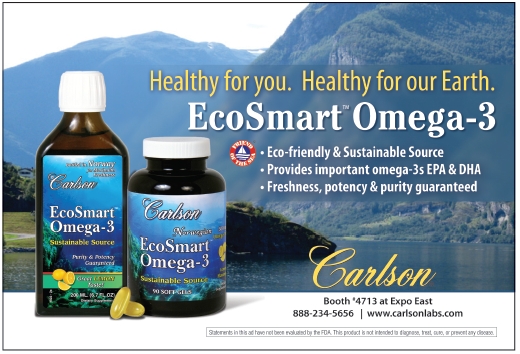
Myers states, “When I talk to consumers, I tell them that omega-3 fatty acids are big, lazy couch potatoes, and they will not get up and do anything unless you pick them up and carry them.” She says that in terms of transportation, phospholipids are like a Ferrari with a large trunk, in that they can carry a lot of omega-3s, quickly and efficiently, to their destinations in the body.
Phospholipids are essential for cognitive health, according to Wael Massrieh, Ph.D., vice president scientific affairs at Neptune Technologies & Bioressources, Laval, QC, Canada. “They are also one of the principle constituents of high-density lipoprotein (good cholesterol) and play, as such, an important role in modulating cholesterol efflux making them beneficial for heart health,” he says.
 The individual phospholipid compounds that have been identified are the subject of much research. Phosphatidylcholines (PCs) are some of the most well-known and understood, according to Myers, who explains that among other things, PCs move DHA into the heart muscle and help prevent oxidative damage to mitochondria. Phosphatidylethanolamine works with PC synergistically to build the myelin sheath of nerve cells and promotes healthy nerve synapse development. Phophatidylserine, also well-known, is thought to be the most widespread phospholipid in the body and plays an important role in cognitive function (3). Phosphatidyl inositol is said to be a precursor of cell-signaling molecules, and to help regulate calcium usage.
The individual phospholipid compounds that have been identified are the subject of much research. Phosphatidylcholines (PCs) are some of the most well-known and understood, according to Myers, who explains that among other things, PCs move DHA into the heart muscle and help prevent oxidative damage to mitochondria. Phosphatidylethanolamine works with PC synergistically to build the myelin sheath of nerve cells and promotes healthy nerve synapse development. Phophatidylserine, also well-known, is thought to be the most widespread phospholipid in the body and plays an important role in cognitive function (3). Phosphatidyl inositol is said to be a precursor of cell-signaling molecules, and to help regulate calcium usage.
The list goes on, but it is important to note that phospholipids in marine oils are generally not standardized for specific amounts, and don’t present the main nutritional component of ingredients, an honor reserved for EPA and DHA. Myers also notes the newly discovered importance of bioactive fish peptides in formulas like that offered by her company. These protein building blocks are being investigated for their significance to cardiovascular and brain health.
Omegas for baby. The role of marine oil compounds in breast milk, mentioned earlier, can be expanded upon to include the impact of omega-3s on fertility and pre- and post-natal nutrition. “Omega-3 fatty acids are precursors to hormones called eicosanoids, which play an important role in the dominant follicle wall rupture during ovulation,” according to information from Fairhaven Health, Bellingham, WA. In other words, they promote fertility. Some research indicates that eicosanoid metabolism deficiencies could be responsible for some cases of female fertility issues.
Omega-3s also help to increase uterine blood flow, regulate hormones, lower cholesterol, elevate mood and increase the rostacyclin/thromboxane ratio, which are hormones important to pregnancy. Anecdotal reports have omega-3 supplementation decreasing cramps, reducing menstrual blood clotting, improving PMS symptoms and increasing cervical mucus (a sign of fertility). Omegas and the marine oils they come from, according to Fairhaven, support the fetus’s brain, eye, ear and cardio respiratory system, just as they support these areas in children and adults. They also can decrease the odds of premature delivery. Once they are out in the world, Fairhaven notes, healthy fatty acids have been linked to improved cognition, visual learning, memory and attention span in infants and young children.
Concentration and Refinement
Manufacturers possess various motivations when deciding how their marine oils will be processed. One is the level of nutrient concentration they are trying to achieve. Another is the need to create safe products, a domain with recognized standards and commonly used purifying procedures. “The Global Organization for EPA and DHA Omega-3 (GOED), and previously the Council for Responsible Nutrition, have set standards for the biggest items of concern: contaminants such as heavy metals, PCBs and dioxins. Industry standards for fish oil purification include steps like molecular distillation, which help to remove unwanted contaminants,” Nomura explains.
“Molecular distillation works by purification under high pressure, protecting the fragile nutritional components of the fish oil while removing contaminants and toxins,” says McRae. Consumers and retailers who are concerned about the purity of a given a marine oil should do their due diligence. Every manufacturer will have its own procedures, but there are commonalities among natural products companies. “We use several proprietary and patented steps in processing our oils—all without chemicals like hexane, or excessive heat, and all while preserving the natural constituents of the oil to the highest degree possible,” says Larsen.
Something to be wary of is the use of heavy solvents by some companies in DHA extraction in particular, according to Martinsen. There is also a need to balance distillation with bioavailability, argues Clouatre. Ethyl ester forms may be purified more easily than other marine oil formats, but he says they are also more susceptible to oxidation and not as bioavailable as other forms.
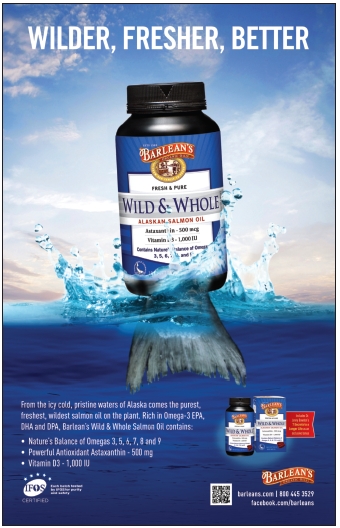 McRae also says to check the label for the amount of EPA and DHA per serving in a product, because current science supports minimum doses of 500 mg per day of each to help prevent chronic disease and minimize the progression of heart disease. This leads us to the other processing question manufacturers face, and that is concentration. Brenda Watson, president and founder of ReNew Life Formulas, Palm Harbor, FL, says that if a fish has its oil extracted, only about 30% of that oil will be omega-3s, the rest being saturated or other unsaturated fat. This is why certain marine oil supplements are concentrated. “Because the recommended dosage of combined EPA plus DHA are generally between 1,000 mg and 4,000 mg, maximizing omega-3 content means that people can take many fewer softgels than it would take to achieve these high dosages,” Watson says.
McRae also says to check the label for the amount of EPA and DHA per serving in a product, because current science supports minimum doses of 500 mg per day of each to help prevent chronic disease and minimize the progression of heart disease. This leads us to the other processing question manufacturers face, and that is concentration. Brenda Watson, president and founder of ReNew Life Formulas, Palm Harbor, FL, says that if a fish has its oil extracted, only about 30% of that oil will be omega-3s, the rest being saturated or other unsaturated fat. This is why certain marine oil supplements are concentrated. “Because the recommended dosage of combined EPA plus DHA are generally between 1,000 mg and 4,000 mg, maximizing omega-3 content means that people can take many fewer softgels than it would take to achieve these high dosages,” Watson says.
A three-to-one ratio of DHA to EPA seems to be naturally occurring in fish, according to Myers, who warns that excessive processing may alter molecules of EPA and DHA, moving them to the terminal ends of the carbon chain. “Omega-3s in the fish look like beach balls sitting in the middle of a knotted rope,” she says. But when certain types of extraction, distillation and purification are used, these beach balls get moved to the end, and Myers says some evidence indicates that this repositioning is significant for the way the body utilizes these molecules. “I think we should be trying to move closer and closer to how it is represented in the fish, because the studies on eating omega-3 rich fish generally outperform the studies on people using it as a supplement,” she says. A further research trend of interest, cited by Myers, involves the notion that lower intakes of key fatty acids may actually be better utilized by the body than higher dosages (4).
Keep things fresh. The importance of stability against rancidity has been mentioned, but is a concept 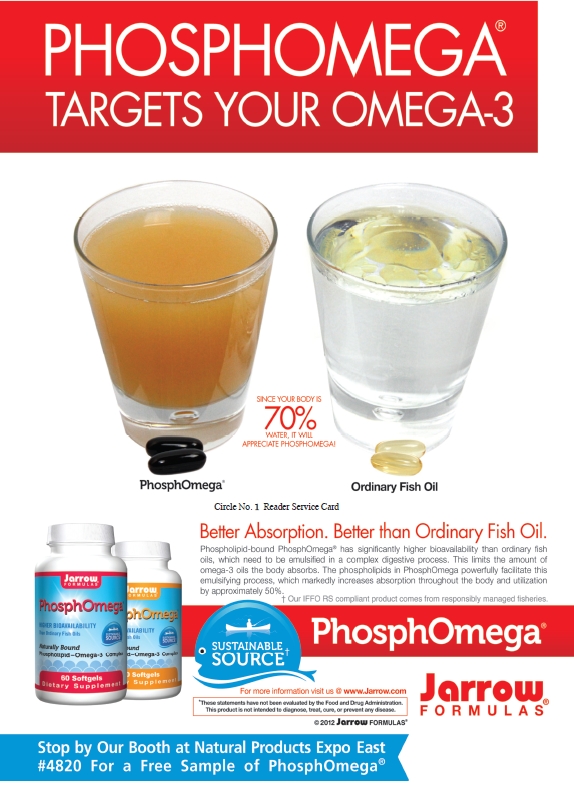 championed by Martinsen, who calls it the difficult part of product formulation with marine oils. He feels it is necessary not to neglect freshness in fish and other marine oils, because a lack of rancidity is tied to the effectiveness of the final product. One important step on the road to freshness is the immediacy with which fish are gathered and have their oil extracted. Keeping them well-frozen is also important, but ultimately all marine oil will turn rancid with time.
championed by Martinsen, who calls it the difficult part of product formulation with marine oils. He feels it is necessary not to neglect freshness in fish and other marine oils, because a lack of rancidity is tied to the effectiveness of the final product. One important step on the road to freshness is the immediacy with which fish are gathered and have their oil extracted. Keeping them well-frozen is also important, but ultimately all marine oil will turn rancid with time.
Something that helps is a low peroxide value, Martinsen notes, adding that his company’s products have a peroxide value that is 1/50 of what GOED recommends. He says that this helps it remain effective at reducing LDL cholesterol, and emphasizes that with fish oil, fishy taste or foul odor is a sign of a lack of freshness.
To this end, the astaxanthin found in krill oil can protect against oxidation, as well as in human tissue (5). “This stops the fatty acids from becoming rancid, making the oil stable for a long time. Astaxanthin also protects body tissues from oxidative damage, the harmful attack that can cause aging of the cells,” Massrieh says, adding that astaxanthin saw a jump in consumer awareness after it was featured on The Dr. Oz Show last year.
The Future of Fishing
Sustainability is an issue not just for the marine oil industry, but also for global fishing practices in general. Most traditional fish oils come from sources that are tightly controlled and regulated, and face relatively few questions about the long-term viability of harvesting operations. Questions do arise, however, and manufacturers must continually reaffirm their sustainability credentials. But krill oil, derived from tiny crustaceans near the bottom of the food chain, has faced challenges from retailers such as Whole Foods Market on the sustainability of harvesting this important species.
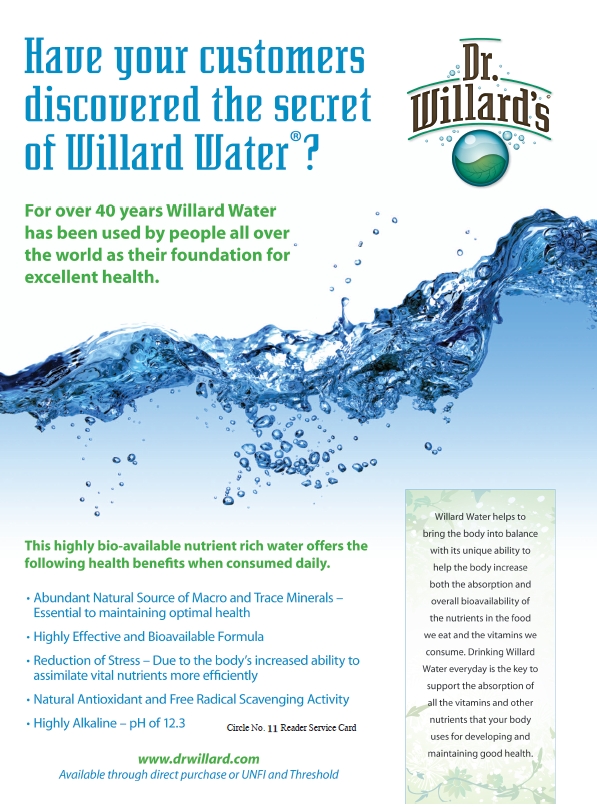 The latest, however, is that Whole Foods Market has eased up on its sustainability concerns, but stated that the chain needs to see further demand in the natural channel for krill oil before it considers selling krill, even as leading manufacturers cite strong sales. As to the reality of the krill sustainability situation, Elzaphan Hotam, CEO of Enzymotec USA Inc., Morristown, NJ, says, “The Convention on the Conservation of Antarctic Marine Living Resources (CCAMLR) and GOED position is that krill is sustainable.” He elaborates that harvest levels are thought to be well below the need for any safety or environmental concern. Krill manufacturers also point to the fact that only a small percentage of harvested krill goes to human consumption, with the rest being used primarily as fish feed.
The latest, however, is that Whole Foods Market has eased up on its sustainability concerns, but stated that the chain needs to see further demand in the natural channel for krill oil before it considers selling krill, even as leading manufacturers cite strong sales. As to the reality of the krill sustainability situation, Elzaphan Hotam, CEO of Enzymotec USA Inc., Morristown, NJ, says, “The Convention on the Conservation of Antarctic Marine Living Resources (CCAMLR) and GOED position is that krill is sustainable.” He elaborates that harvest levels are thought to be well below the need for any safety or environmental concern. Krill manufacturers also point to the fact that only a small percentage of harvested krill goes to human consumption, with the rest being used primarily as fish feed.
In 1980, CCAMLR was ratified and it came into force in 1982. It was established due to commercial interest in Antarctic krill resources, a keystone of the Antarctic ecosystem, according to Massrieh. CCAMLR is an international commission with 25 members and consent from 10 more countries. Annually, the commission reviews krill fisheries and sets maximum quotas. In 2010–2011, Massrieh explains, the precautionary catch limit was set at a small percentage of the total krill biomass. Of that amount, only a miniscule percentage of krill was actually caught.
“The misconceptions around krill sustainability have been a significant hindrance to the acceptance of krill oil in the natural products channel,” says Eric Anderson, vice president of marketing for Aker BioMarine, Issaquah, WA. Noting krill’s status as a keystone species that is vitally important to the marine food chain, Anderson says that krill are in every ocean on Earth and are arguably the world’s most successful species, having the single largest biomass.
Anderson’s company has a formal partnership with World Wildlife  Fund–Norway. Anderson says that Nina Jensen, conservation director with that organization, has described his company as a proactive player that has contributed substantially to research on krill’s place in the ecosystem. He notes that the total catch of all krill harvesters today is less than one-third of 1% of the krill population in one defined area.
Fund–Norway. Anderson says that Nina Jensen, conservation director with that organization, has described his company as a proactive player that has contributed substantially to research on krill’s place in the ecosystem. He notes that the total catch of all krill harvesters today is less than one-third of 1% of the krill population in one defined area.
The tangible aspect of this commitment to sustainability for some companies has been Marine Stewardship Council (MSC) certification, a leading eco-label that designates a sustainable, traceable seafood supply chain. MSC certification, according to Anderson, is based on three tenets: the health of the biomass, the impact of the fishery on the ecosystem, and complete traceability from harvest to consumer.
Despite the young age of the krill fishery as related to the supplements industry, the key players have joined on the subject of sustainability, according to Massrieh, who says, “More communication efforts will need to be put forward to educate the industry stakeholders and the general public.”
What Lies Ahead
It is a subject of unique interest to those involved in the manufacturing and marketing of marine oils, but the question of this market’s future is also of import to the retailers who must sell these products. It may seem as if the market, at least in North America, has reached or is approaching a point of saturation. Such a large percentage of adults take their daily fish oil now, it is hard to imagine profits continuing to increase ad infinitum. Clouatre takes consumer health into consideration, too, by arguing that a naturally rich diet may be in order at this juncture. “It is likely the case that the category is approaching saturation in terms of supplement consumption. Omega-3 fatty acids need to return to more prominent roles in foods if the current unhealthy level of omega-6 fatty acids is to be reduced to a more desirable balance with omega-3s,” he says.
But for their basic significance to general health and well being, omega-3 supplements and marine oils seem set to hang around for a while, and thrive. There are high concentrations of DHA in the fetal brain and early neural development, especially the last trimester, according to Watson. Low DHA levels can contribute to cognitive decline and vision problems. “Because the primary mechanism of omega-3 EPA and DHA involves support of healthy inflammatory response, and most, if not all, chronic disease involves chronic inflammation, the potential for omega-3s to benefit a range of consumers is great,” Watson says.
Add in external factors, and it’s clear the marine oils market likely won’t sag any time soon. “With heart disease continually increasing in the United States due to multiple factors (including inactivity and obesity), fish oils have a lot to contribute to the quality of life for consumers as a whole,” says Nomura. Martinsen only advises that there should be a research and marketing focus on effective dosages for these conditions. He says if the consumer can’t feel a difference, then a product’s success will not be longed lived.
Hotam believes the most explosive growth for the category may be globally. Larsen agrees, stating, “As a company that distributes to more than 35 countries, we can confidently say there are many, many people who are still learning about the important health benefits  of omega-3.”
of omega-3.”
Meanwhile, there is promise on the home front. “In North America, the omega-3 market is well-established, representing 40% of the global demand and has been estimated to continue to grow through 2016,” says Massrieh. Domestically, Hotam says that future growth may involve food applications for marine oils, something we’ve already started to see. Omega-3s, sometimes in the form of marine oil, have wound their way into everything from orange juice to yogurt (6). As far as keeping the supplements market dynamic, he believes second-generation products such as krill may hold consumers’ attention.
Another necessity in advancing the supplements market is improving quality. Myers notes that all oils still do not possess good stability. “When we look at unstable oil, it actually creates free radical damage in our bodies, it creates oxidative stress,” she says. This puts the consumer’s health in a one step forward, two steps back, scenario, where rancidity creates hard-to-quench hydroxyl free radicals in the body. Using up bodily stores of glutathione to quench these unnecessary free radicals hurts one’s chances of preventing future damage, she explains. There is also the need, she says, to educate consumers that marine oils don’t have to taste poorly, something that may finally entice consumers that have been kept away by this issue.
In general, “The ‘Fatty Acid Story’ is a complex one that can be difficult to convey,” says McRae. Over time, the message about the beneficial compounds in marine oils has reached the average consumer. As consumers get even savvier, her company sees greater potential for specifically targeted formulas to address the needs of various age groups and either gender, and a focus on alternate delivery formats.
Specific molecules targeted to specific conditions is an area of untapped potential in the omega-3 space, according to Israel. Early research is uncovering the way certain complexes of omega-3s bound with phospholipids or triglycerides can impact different bodily tissues. The combination of omega-3s with natural proteins, carbohydrates and other compounds has the potential to affect cell signaling and permeability, and to influence the body’s utilization of proteins. But the specter of regulation ever looms. “Determining if these new materials are drugs or foods will prove to be a challenging question,” Israel says.
The demand promises to be so great, in Anderson’s view, that it is a serious question whether either we, or the oceans, can keep up. While they may come in all shapes in sizes, every marine oil product essentially derives from this same shared resource. “Global demand for omega-3s is continuing to grow, and within a few years the demand will be greater than existing supplies of fish oil,” he says, continuing, “We are big fans of omega-3s from all sources, including fish, plants and krill, etc. These essential fatty acids are important nutrients for human health. Consumers are fortunate today to have a number of interesting sources.” WF
References
1. S. Shiba, et al., “Regulation of lipid metabolism by palmitoleate and eicosapentaenoic acid (EPA) in mice fed a high-fat diet,” Biosci Biotechnol Biochem. 75(12), 2401-3 (2011).
2. F. Natali, et al., “Oleic acid is a potent inhibitor of fatty acid and cholesterol synthesis in C6 glioma cells,” The Journal of Lipid Research 48(9), 1966-1975 (2007).
3. “Phosphatidylserine,” WebMD, http://www.webmd.com/vitamins-supplements/ingredientmono-992-PHOSPHATIDYLSERINE.aspx?activeIngredientId=992&activeIngredientName=PHOSPHATIDYLSERINE, accessed Aug. 1, 2012.
4. C. Calzada, et al., “Subgram daily supplementation with docosahexaenoic acid protects
low-density lipoproteins from oxidation in healthy men,” Atherosclerosis 208, 467–472 (2010).
5. K. Nakagawa, et al., “Antioxidant effect of astaxanthin on phospholipid peroxidation in human erythrocytes,” Br J Nutr. 105(11), 1563-71 (2011).
6. J.D. Estrada, et al., “Developing a strawberry yogurt fortified with marine fish oil,” J Dairy Sci. 94(12), 5760-9 (2011).
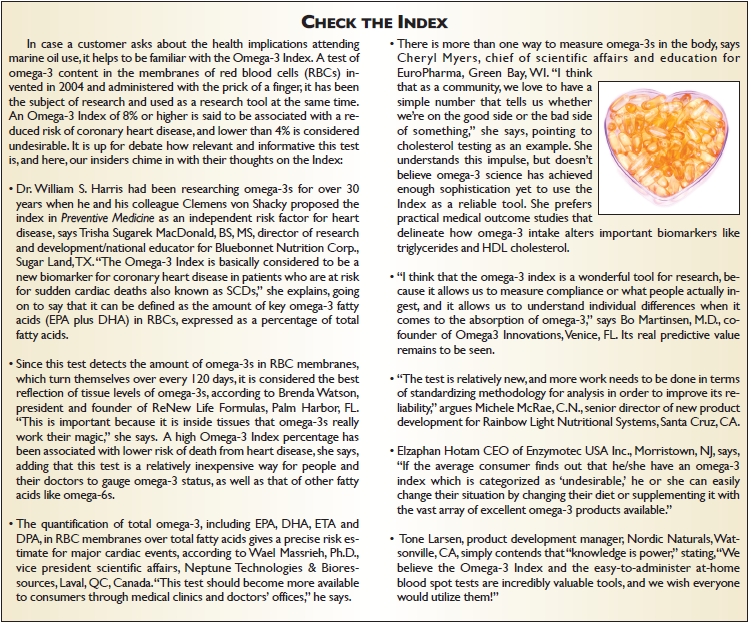
Published in WholeFoods Magazine, September 2012









